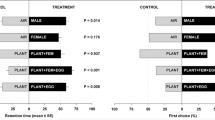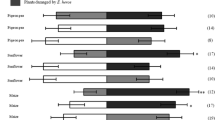Abstract
The bethylid wasps Cephalonomia stephanoderis Betrem and Prorops nasuta Waterston are parasitoids of the coffee berry borer, Hypothenemus hampei (Ferrari), the most serious insect pest of coffee worldwide. Recent studies on the host location behaviour of these parasitoids have shown that females are attracted to volatile compounds released by immature stages and dust/frass of H. hampei. Also, these studies have reported that the locomotory behaviour of parasitoids is influenced by contact chemical cues from host dust/frass. In this study, we investigated the responses of females of both species to volatiles and contact cues from dust/frass from different sources. Volatiles from dust/frass from H. hampei-infested coffee and maize infested with Sitophilus sp were attractive to P. nasuta females. In contrast, C. stephanoderis females were only attracted to the volatiles from dust/frass from H. hampei-infested coffee. Volatiles from an artificial diet used for rearing H. hampei were not attractive to females of both species. The effect of methanolic extracts from dust/frass from different sources on the patch-searching time of parasitoids was analysed using the Ethovision software. P. nasuta females spent more time in the patches treated with extracts of dust/frass from H. hampei-infested berries, artificial diet, and from maize infested with Sitophilus sp than on patches treated with dry coffee extract or solvent control. C. stephanoderis females spent more time on patches treated with dust/frass extracts from H. hampei-infested berries and artificial diet than on patches treated with an extract of dust/frass from maize infested with Sitophilus sp, an extract of dry coffee, and methanol control.


Similar content being viewed by others
References
Abraham YD, Moore D, Godwin G (1990) Rearing and aspects of biology of Cephalonomia stephanoderis and Prorops nasuta (Hymenoptera: Bethylidae) parasitoids of the coffee berry borer, Hypothenemus hampei (Coleoptera: Scolytidae). Bull Entomol Res 80:121–128
Barrera JF (2008) Coffee pests and their management. In: Capinera JL (ed) Encyclopedia of entomology, 2nd edn. Springer, Dordrecht, NL, pp 961–998
Barrera JF, Baker PS, Valenzuela JE, Schwarz A (1990) Introducción de dos especies de parasitoides Africanos a México para el control biológico de la broca del café, Hypothenemus hampei (Ferrari) (Coleoptera: Scolytidae). Folia Entomol Mex 79:245–247
Batchelor TP, Hardy ICW, Barrera JF, Pérez-Lachaud G (2005) Insect gladiators II: competitive interactions within and between bethylid parasitoid species of the coffee berry borer, Hypothenemus hampei (Coleoptera: Scolytidae). Biol Control 33:194–202
Boo KS, Yang JP (2000) Kairomones used by Trichogramma chilonis to find Helicoverpa assulta eggs. J Chem Ecol 26:359–375
Chiu-Alvarado MP (2007) Host location by parasitoids of the coffee berry borer, Hypothenemus hampei (Ferrari) (Coleoptera: Curculionidae: Scolytinae). D. Phil. Thesis, Oxford University, UK
Chiu-Alvarado P, Rojas JC (2008) Host location behavior by two Cephalonomia spp. (Hymenoptera: Bethylidae) wasps associated with the coffee berry borer, Hypothenemus hampei (Coleoptera: Curculionidae: Scolytinae). Int J Trop Insect Sci 28:179–184
Chiu-Alvarado P, Barrera JF, Rojas JC (2009) Attraction of Prorops nasuta, a parasitoid of the coffee berry borer, to host-associated olfactory cues. Ann Entomol Soc Am 102:166–171
Chiu-Alvarado P, Valle-Mora J, Rojas JC (2010) Chemical cues from the coffee berry borer influence the locomotory behaviour of its bethylid parasitoids. Bull Entomol Res. doi:10.1017/S0007485310000064
Conti E, Salerno G, Bin F, Vinson SB (2004) The role of host semiochemicals in parasitoid specificity: a case study with Trissolcus brochymenae and Trissolcus simoni on pentatomid bugs. Biol Control 29:435–444
Ding D, Swedenborg PD, Jones RL (1989) Chemical stimuli in host-seeking behavior of Macrocentrus grandis (Hymenoptera: Braconidae). Ann Entomol Soc Am 82:232–236
Gandolfi M, Mattiacci L, Dorn S (2003) Mechanisms of behavioural alterations of parasitoids reared in artificial systems. J Chem Ecol 29:1871–1877
Godfray HCJ (1994) Parasitoids: behavioral, and evolutionary ecology. Princeton University Press, Princeton, NJ, USA
Howard RW, Flinn P (1990) Larval trails of Cryptolestes ferrugineus (Coleoptera: Cucujidae) as kairomonal host-finding cues for the parasitoid Cephalonomia waterstoni (Hymenoptera: Bethylidae). Ann Entomol Soc Am 83:239–245
Koch VJM (1973) Abondance de Hypothenemus hampei (Ferr.), scolyte des graines de café, en fonction de sa plante-hôte et de son parasite Cephalonomia stephanoderis Betrem, en Côte d’Ivoire. Mededelingen Landbouwhogeschool, Wageningen, 84 pp
Lauzière I, Brodeur J, Pérez-Lachaud G (2001) Host stage selection and suitability in Cephalonomia stephanoderis Betrem (Hymenoptera: Bethylidae), a parasitoid of the coffee berry borer. Biol Control 21:128–133
Le Pelley RH (1968) Pests of coffee. Longmans Green, London, UK
López-Rodríguez MA, Chiu-Alvarado MP, Rojas JC (2009) Factores que afectan la atracción de Prorops nasuta Waterston (Hymenoptera: Bethylidae) a los olores emitidos por los desechos de su huésped, la broca del café. Acta Zool Mex (ns) 25:49–60
Martínez A, Fernandez-Arhex V, Corley JC (2006) Chemical information from the fungus Amylostereum areolatum and host-foraging behaviour in the parasitoid Ibalia leocospoides. Physiol Entomol 31:336–340
Murphy ST, Moore D (1990) Biological control of the coffee berry borer, Hypothenemus hampei (Ferrari) (Coleoptera: Scolitydae): serious programmes and possibilities for the future. Biocontrol News Inf 11:107–117
Pérez J, Infante F, Vega FE, Holguin F, Macias J, Valle J, Nieto G, Petterson SW, Kurtzman CP, O’Donnell K (2003) Microbiota associated with the coffee berry borer (Hypothenemus hampei) in Mexico. Mycol Res 107:879–887
Pérez-Lachaud G, Hardy ICW (2001) Alternative hosts for bethylid parasitoids of the coffee berry borer, Hypothenemus hampei (Coleoptera: Scolytidae). Biol Control 22:265–277
Ramachandran R, Norris DM, Phillips JK, Phillips TW (1991) Volatiles mediating plant–herbivore–natural enemy interactions: soybean looper frass volatiles, 3-octanone and guaicol, as kairomones for the parasitoid Microplitis demolitor. J Agric Food Chem 39:2310–2317
Roman-Ruiz AK (2007) Aislamiento e identificación de los volátiles de los desechos alimenticios y fecales de la broca del café atractivos al parasitoide Prorops nasuta. Unpublished M.Sc. Thesis, Universidad Autónoma de Chiapas, Mexico
Schröder R, Hilker M (2008) The relevance of background odor in resource location by insects: a behavioral approach. Bioscience 58:308–316
Sokal RR, Rohlf CW (1995) Biometry, 3rd edn. WH Freeman, San Francisco, CA, USA
Steidle JLM, Scholler M (1997) Olfactory host location and learning in the granary weevil parasitoid Lariophagous distinguendus (Hymenoptera: Pteromalidae). J Insect Behav 10:331–342
Steidle JLM, van Loon JJA (2003) Dietary specialization and infochemical use in carnivorous aethropods: testing a concept. Entomol Exp Appl 108:133–148
Steiner S, Erdmann D, Steidle JLM, Ruther J (2007) Host habitat assessment by a parasitoid using fungal volatiles. Front Zool 4:3. doi:10.1186/1742-9994-4-3
Vet LEM, Dicke D (1992) Ecology of infochemical use by natural enemies in a tritrophic context. Annu Rev Entomol 37:141–172
Villacorta A, Barrera JF (1996) Techniques for mass rearing of the parasitoid Cephalonomia stephanoderis (Hymenoptera: Bethylidae) on Hypothenemus hampei (Coleoptera: Scolytidae) using an artificial diet. Vedalia 3:45–48
Vinson SB (1998) The general host selection behavior of parasitoid Hymenoptera and a comparison of initial strategies utilized by larvaphagous and oophagous species. Biol Control 11:79–96
Acknowledgments
We thank Juan Barrera and Armando Virgen for encouragement during the course of this study, and technical assistance, respectively. We also thank Gabriela Pérez-Lachaud for her helpful comments on earlier drafts of the manuscript. The English text was corrected by Julian Flavell. This study was supported by CONACyT through grant (project no. 40338Q) to JCR, and a graduate scholarship to Pilar Chiu-Alvarado.
Author information
Authors and Affiliations
Corresponding author
Additional information
Handling Editor: Torsten Meiners.
Pilar Chiu-Alvarado—Deceased.
Rights and permissions
About this article
Cite this article
Chiu-Alvarado, P., Rojas, J.C. Behavioural responses of bethylid parasitoid species of the coffee Berry borer to chemicals cues from host and non-host dust/frass. BioControl 56, 45–53 (2011). https://doi.org/10.1007/s10526-010-9315-9
Received:
Accepted:
Published:
Issue Date:
DOI: https://doi.org/10.1007/s10526-010-9315-9




